Drainage Ditch Berm Delineation Using Lidar Data: A Case Study of Waseca County, Minnesota
Abstract
1. Introduction
2. Materials and Methods
3. Results
3.1. Hillshade Analysis
3.2. Berm Extraction
3.3. Accuracy Estimation
3.4. Landuse Types within Buffer Area
4. Discussion
4.1. Importance of Results
4.2. Landscape Planning Modeling and Management
5. Conclusions
Author Contributions
Funding
Conflicts of Interest
References
- Minár, J.; Evans, I.S. Elementary forms for land surface segmentation: The theoretical basis of terrain analysis and geomorphological mapping. Geomorphology 2008, 95, 236–259. [Google Scholar] [CrossRef]
- Evans, I.S. Geomorphometry and landform mapping: What is a landform? Geomorphology 2012, 137, 94–106. [Google Scholar] [CrossRef]
- Strahler, A.N. Quantitative analysis of watershed geomorphology. Trans. Am. Geophys. Union 1957, 38, 913–920. [Google Scholar] [CrossRef]
- Wilson, J.P. Digital terrain modeling. Geomorphology 2012, 137, 107–121. [Google Scholar] [CrossRef]
- Blaszcynski, J.S. Landform characterization with geographic information systems. Photogramm. Eng. Remote Sens. 1997, 63, 183–191. [Google Scholar]
- Bishop, M.P.; James, L.A.; Shroder, J.F.; Walsh, S.J. Geospatial technologies and digital geomorphological mapping: Concepts, issues and research. Geomorphology 2012, 137, 5–26. [Google Scholar] [CrossRef]
- Drăguţ, L.; Eisank, C. Object representations at multiple scales from digital elevation models. Geomorphology 2011, 129, 183–189. [Google Scholar] [CrossRef]
- Fisher, P.; Wood, J.; Cheng, T. Where is Helvellyn? Fuzziness of multi-scale landscape morphometry. Trans. Inst. Br. Geogr. 2004, 29, 106–128. [Google Scholar] [CrossRef]
- Schmidt, J.; Hewitt, A. Fuzzy land element classification from DTMs based on geometry and terrain position. Geoderma 2004, 121, 243–256. [Google Scholar] [CrossRef]
- Weissel, J.K.; Pratson, L.F.; Malinverno, A. The length-scaling properties of topography. J. Geophys. Res. Space Phys. 1994, 99, 13997–14012. [Google Scholar] [CrossRef]
- Heimlich, R.E.; Wiebe, K.D.; Claassen, R.; Gadsby, D.; House, R.M. Wetlands and Agriculture: Private Interests and Public Benefits; Resource Economics Division, Economic Research Service, US Department of Agriculture: Washington, DC, USA, 1998.
- Smedema, L.K.; Vlotman, W.F.; Rycroft, D. Modern Land Drainage: Planning, Design and Management of Agricultural Drainage Systems; CRC Press: Abingdon, UK, 2004. [Google Scholar]
- Skaggs, R.W.B.; Brevé, M.A.; Gilliam, J.W. Hydrologic and water quality impacts of agricultural drainage*. Crit. Rev. Environ. Sci. Technol. 1994, 24, 1–32. [Google Scholar] [CrossRef]
- Strock, J.S.; Dell, C.J.; Schmidt, J.P. Managing natural processes in drainage ditches for nonpoint source nitrogen control. J. Soil Water Conserv. 2007, 62, 188–196. [Google Scholar]
- Montgomery, D.R. Road surface drainage, channel initiation, and slope instability. Water Resour. Res. 1994, 30, 1925–1932. [Google Scholar] [CrossRef]
- Dahl, T.E.; Allord, G.J. History of Wetlands in the Conterminous United States; Fretwell, J.D., Williams, J.S., Redman, P.J., Eds.; National Water Summary on Wetland Resources, USGS Water-Supply, Paper US Geological Survey: Washington, DC, USA, 1996; Volume 2425, pp. 19–26.
- Pavelis, G.A. Farm Drainage in the United States: History, Status, and Prospects; US Department of Agriculture, Economic Research Service: Washington, DC, USA, 1987.
- Tiner, R.W., Jr. Wetlands of the United States: Current Status and Recent Trends; National Wetlands Inventory; Newton Corner, Massachusetts, US Department of the Interior, Fish and Wildlife Service: Washington, DC, USA, 1984. [Google Scholar]
- Glaser, P.H.; Wheeler, G.A.; Gorham, E.; Wright, H.E. The Patterned Mires of the Red Lake Peatland, Northern Minnesota: Vegetation, Water Chemistry and Landforms. J. Ecol. 1981, 69, 575–599. [Google Scholar] [CrossRef]
- Burwell, R.W.; Sugden, L.G. Potholes—Going, going. In Waterfowl Tomorrow; US Fish and Wildlife Service: Washington, DC, USA, 1964; pp. 369–380. [Google Scholar]
- Frayer, W.E. Status and Trends of Wetlands and Deepwater Habitats in the Conterminous United States, 1950’s to 1970’s; Dept. of Forest and Wood Sciences, Colorado State University: Fort Collins, CO, USA, 1983. [Google Scholar]
- Claassen, R.; Cattaneo, A.; Johansson, R. Cost-effective design of agri-environmental payment programs: U.S. experience in theory and practice. Ecol. Econ. 2008, 65, 737–752. [Google Scholar] [CrossRef]
- Ribaudo, M.; Hoag, D.L.; Smith, M.E.; Heimlich, R. Environmental indices and the politics of the Conservation Reserve Program. Ecol. Indic. 2001, 1, 11–20. [Google Scholar] [CrossRef]
- Stuart, D.; Gillon, S. Scaling up to address new challenges to conservation on US farmland. Land Use Policy 2013, 31, 223–236. [Google Scholar] [CrossRef]
- Gene, S.; Hoekstra, P.; Hannam, C.; White, M.; Truman, C.; Hanson, M.; Prosser, R. The role of vegetated buffers in agriculture and their regulation across Canada and the United States. J. Environ. Manag. 2019, 243, 12–21. [Google Scholar] [CrossRef]
- Kreig, J.A.; Ssegane, H.; Chaubey, I.; Negri, M.C.; Jager, H.I. Designing bioenergy landscapes to protect water quality. Biomass Bioenergy 2019, 128, 10532. [Google Scholar] [CrossRef]
- Srinivas, R.; Drewitz, M.; Magner, J. Evaluating watershed-based optimized decision support framework for conservation practice placement in Plum Creek Minnesota. J. Hydrol. 2020, 583, 124573. [Google Scholar] [CrossRef]
- Planting Ditches with Perennial Vegetation, Minnesota Statutes 2019. Available online: https://www.revisor.mn.gov/statutes/cite/103E.021 (accessed on 5 November 2020).
- Riparian Protection and Water Quality Practices, Minnesota Statutes 2019. Available online: https://www.revisor.mn.gov/statutes/cite/103F.48 (accessed on 5 November 2020).
- Miller, T.P.; Peterson, J.R.; Lenhart, C.F.; Nomura, Y. The Agricultural BMP Handbook for Minnesota; Minnesota Department of Agriculture: St. Paul, MN, USA, 2012.
- Xu, S.; Li, S.-L.; Zhong, J.; Li, C. Spatial scale effects of the variable relationships between landscape pattern and water quality: Example from an agricultural karst river basin, Southwestern China. Agric. Ecosyst. Environ. 2020, 300, 106999. [Google Scholar] [CrossRef]
- Mayer, P.M.; Reynolds, S.K., Jr.; McCutchen, M.D.; Canfield, T.J. Meta-Analysis of Nitrogen Removal in Riparian Buffers. J. Environ. Qual. 2007, 36, 1172–1180. [Google Scholar] [CrossRef] [PubMed]
- Yamada, T.; Logsdon, S.D.; Tomer, M.D.; Burkart, M.R. Groundwater nitrate following installation of a vegetated riparian buffer. Sci. Total. Environ. 2007, 385, 297–309. [Google Scholar] [CrossRef] [PubMed]
- Ranjan, P.; Singh, A.S.; Tomer, M.D.; Lewandowski, A.M.; Prokopy, L.S. Lessons learned from using a decision-support tool for precision placement of conservation practices in six agricultural watersheds in the US midwest. J. Environ. Manag. 2019, 239, 57–65. [Google Scholar] [CrossRef] [PubMed]
- Devereux, B.J.; Amable, G.; Crow, P.; Cliff, A. The potential of airborne lidar for detection of archaeological features under woodland canopies. Antiquity 2005, 79, 648–660. [Google Scholar] [CrossRef]
- An Evaluation of Automated GIS Tools for Delineating Karst Sinkholes and Closed Depressions from 1-Meter LiDAR-Derived Digital Elevation Data. Available online: https://pubs.er.usgs.gov/publication/70195369 (accessed on 5 November 2020).
- MacMillan, R.A.; Martin, T.C.; Earle, T.J.; McNabb, D.H. Automated analysis and classification of landforms using high-resolution digital elevation data: Applications and issues. Can. J. Remote. Sens. 2003, 29, 592–606. [Google Scholar] [CrossRef]
- McCoy, M.; Asner, G.P.; Graves, M.W. Airborne lidar survey of irrigated agricultural landscapes: An application of the slope contrast method. J. Archaeol. Sci. 2011, 38, 2141–2154. [Google Scholar] [CrossRef]
- Doneus, M.; Kühteiber, T. Airborne laser scanning and archaeological interpretation–bringing back the people. In Interpreting Archaeological Topography: Airborne Laser Scanning, 3D Data, and Ground Observation; Occasional Publication of the Aerial Archaeology Research Group, Oxbow Books: Oxford, UK, 2013; pp. 32–50. [Google Scholar]
- Lindsay, J.B.; Dhun, K. Modelling surface drainage patterns in altered landscapes using LiDAR. Int. J. Geogr. Inf. Sci. 2015, 29, 397–411. [Google Scholar] [CrossRef]
- Magesh, N.S.; Ch, N. A GIS based automated extraction tool for the analysis of basin morphometry. Bonfring Int. J. Ind. Eng. Manag. Sci. Spec. Issue Geospat. Technol. Dev. Nat. Resour. Disaster Manag. 2012, 2, 32–35. [Google Scholar]
- Reddy, G.P.O.; Maji, A.K.; Gajbhiye, K.S. Drainage morphometry and its influence on landform characteristics in a basaltic terrain, Central India–a remote sensing and GIS approach. Int. J. Appl. Earth Obs. Geoinf. 2004, 6, 1–16. [Google Scholar] [CrossRef]
- Saadat, H.; Bonnell, R.; Sharifi, F.; Mehuys, G.; Namdar, M.; Ale-Ebrahim, S. Landform classification from a digital elevation model and satellite imagery. Geomorphology 2008, 100, 453–464. [Google Scholar] [CrossRef]
- Garcia, G.P.; Grohmann, C.H. DEM-based geomorphological mapping and landforms characterization of a tropical karst environment in southeastern Brazil. J. S. Am. Earth Sci. 2019, 93, 14–22. [Google Scholar] [CrossRef]
- Jaballah, M.; Camenen, B.; Paquier, A.; Jodeau, M. An optimized use of limited ground based topographic data for river applications. Int. J. Sediment Res. 2019, 34, 216–225. [Google Scholar] [CrossRef]
- Prufer, K.M.; Thompson, A.E.; Kennett, D.J. Evaluating airborne LiDAR for detecting settlements and modified landscapes in disturbed tropical environments at Uxbenká, Belize. J. Archaeol. Sci. 2015, 57, 1–13. [Google Scholar] [CrossRef]
- Garrison, T.G.; Garrison, T.G.; Firpi, O.A. Recentering the rural: Lidar and articulated landscapes among the Maya. J. Anthr. Archaeol. 2019, 53, 133–146. [Google Scholar] [CrossRef]
- Anemone, R.L.; Conroy, G.C.; Emerson, C.W. GIS and paleoanthropology: Incorporating new approaches from the geospatial sciences in the analysis of primate and human evolution. Am. J. Phys. Anthr. 2011, 146, 19–46. [Google Scholar] [CrossRef]
- Davis, O. Processing and Working with LiDAR Data in ArcGIS: A Practical Guide for Archaeologists; Royal Commission of the Ancient and Historical Monuments of Wales: Aberystwyth, UK, 2012.
- Harmon, J.M.; Leone, M.P.; Prince, S.D.; Snyder, M. Lidar for archaeological landscape analysis: A case study of two eighteenth-century Maryland plantation sites. Am. Antiq. 2006, 71, 649–670. [Google Scholar] [CrossRef]
- Verhagen, P.; Drăguţ, L. Object-based landform delineation and classification from DEMs for archaeological predictive mapping. J. Archaeol. Sci. 2012, 39, 698–703. [Google Scholar] [CrossRef]
- Chalkias, C.; Faka, A. Risk evaluation by modelling exposure to direct sunlight on rural highways—A GIS approach. In Proceedings of the 11th WSEAS International Conference on Mathematical Methods and Computational Techniques in Electrical Engineering, Athens, Greece, 28–30 September 2009; World Scientific and Engineering Academy and Society (WSEAS): Athens, Greece, 2009; pp. 373–378. [Google Scholar]
- Veronesi, F.; Hurni, L. A GIS tool to increase the visual quality of relief shading by automatically changing the light direction. Comput. Geosci. 2015, 74, 121–127. [Google Scholar] [CrossRef]
- U.S Census Bureau. 2019, Population Estimates Program. US/PST045219. Available online: https://www.census.gov/quickfacts/fact/table/wasecacountyminnesota (accessed on 5 November 2020).
- Minnesota Geospatial Commons. Available online: https://www.mngeo.state.mn.us/chouse/elevation/lidar.html (accessed on 5 July 2019).
- ESRI. Hillshade Function. 2020. Available online: https://desktop.arcgis.com/en/arcmap/10.5/manage-data/raster-and-images/hillshade-function.htm (accessed on 5 November 2020).
- ESRI. How Filter Works. 2020. Available online: https://desktop.arcgis.com/en/arcmap/10.5/tools/spatial-analyst-toolbox/how-filter-works.htm (accessed on 5 November 2020).
- Cottrell, A.; Lucchetti, R. Gretl user ManualGretl user Manual. 2007. Available online: http://gretl.sourceforge.net/ (accessed on 5 November 2020).
- Shaker, R.R.; Yakubov, A.D.; Nick, S.M.; Vennie-Vollrath, E.; Ehlinger, T.J.; Forsythe, K. Predicting aquatic invasion in Adirondack lakes: A spatial analysis of lake and landscape characteristics. Ecosphere 2017, 8, e01723. [Google Scholar] [CrossRef]
- The Development and Evaluation of Methods for Quantifying Risk to Fish in Warm-water Streams of Wisconsin Using Self Organized Maps: Influences of Watershed and Habitat Stressors. Available online: https://repository.library.northeastern.edu/files/neu:329785 (accessed on 17 November 2020).
- Agricultural Land Fragmentation and Biological Integrity: The impacts of a Rapidly Changing Landscape on Streams in Southeastern Wisconsi. Available online: https://static1.squarespace.com/static/5e1253990612347a7d3eb094/t/5e4de32d50bc066ba3f6564f/1582162735857/Shaker_Ehlinger_2007_Aglands_Aquatic_Ecology.pdf (accessed on 17 November 2020).
- Todeschini, S.; Papiri, S.; Sconfietti, R. Impact assessment of urban wet-weather sewer discharges on the Vernavola River (Northern Italy). Civ. Eng. Environ. Syst. 2011, 28, 209–229. [Google Scholar] [CrossRef]
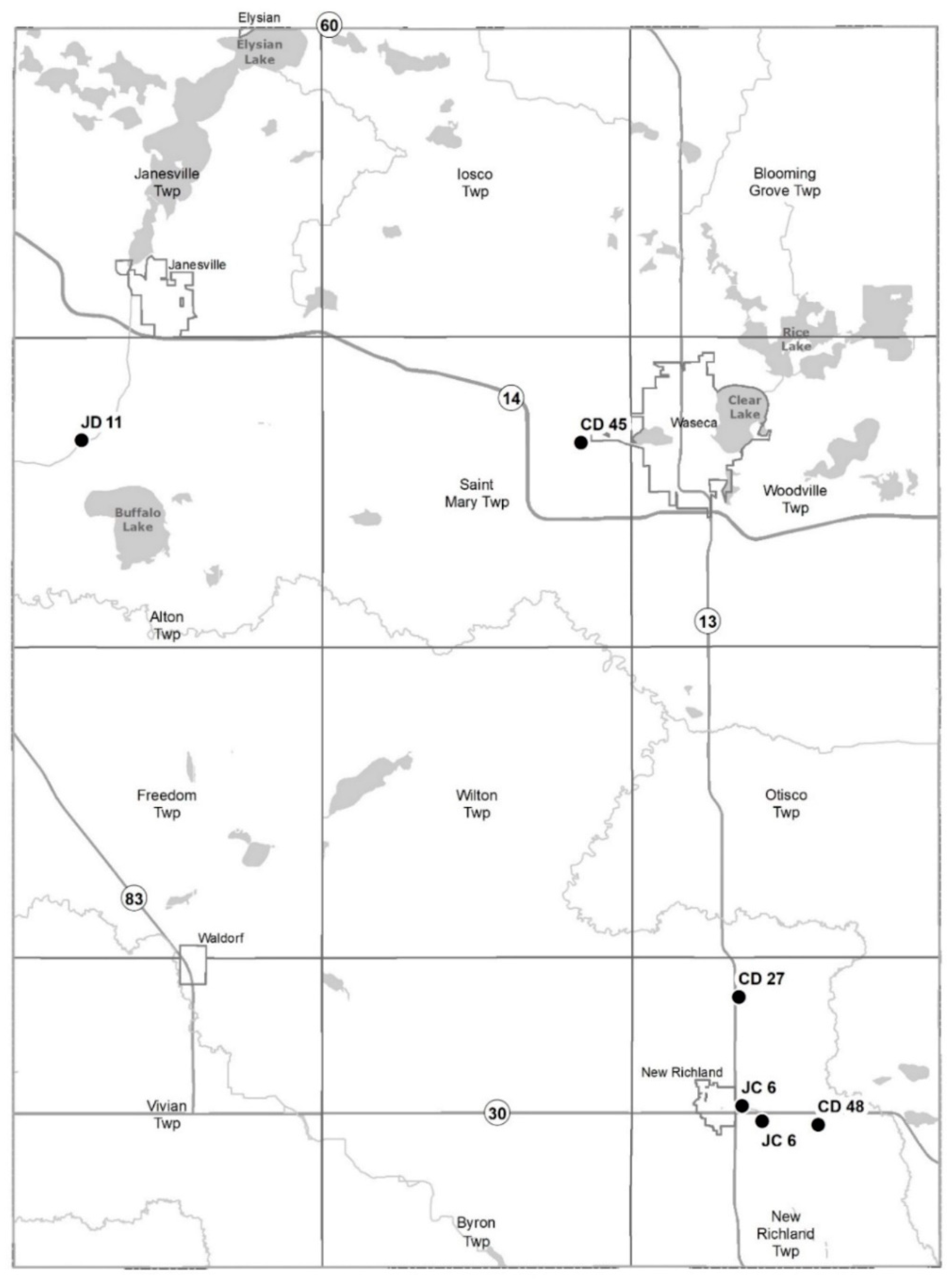
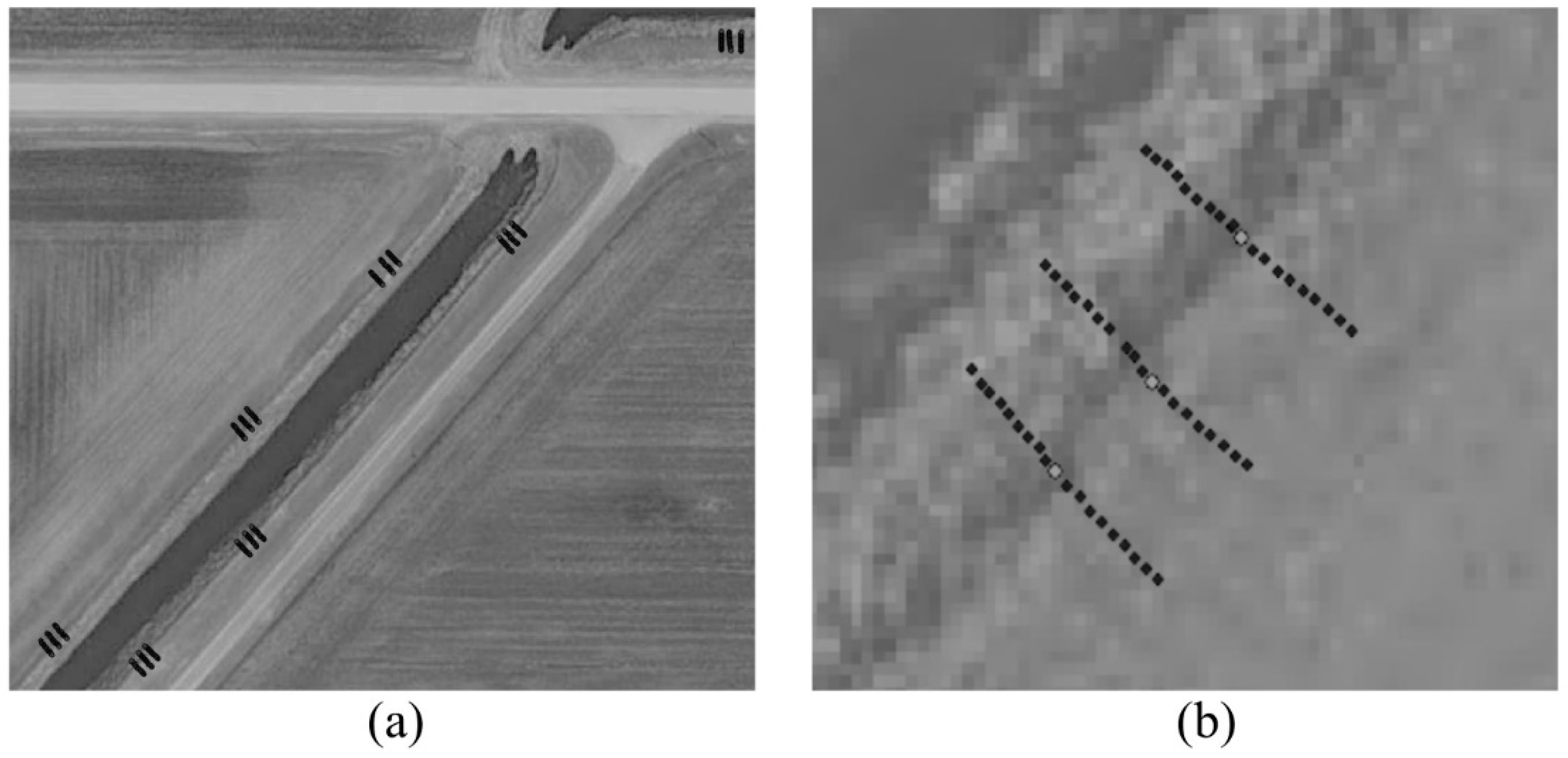

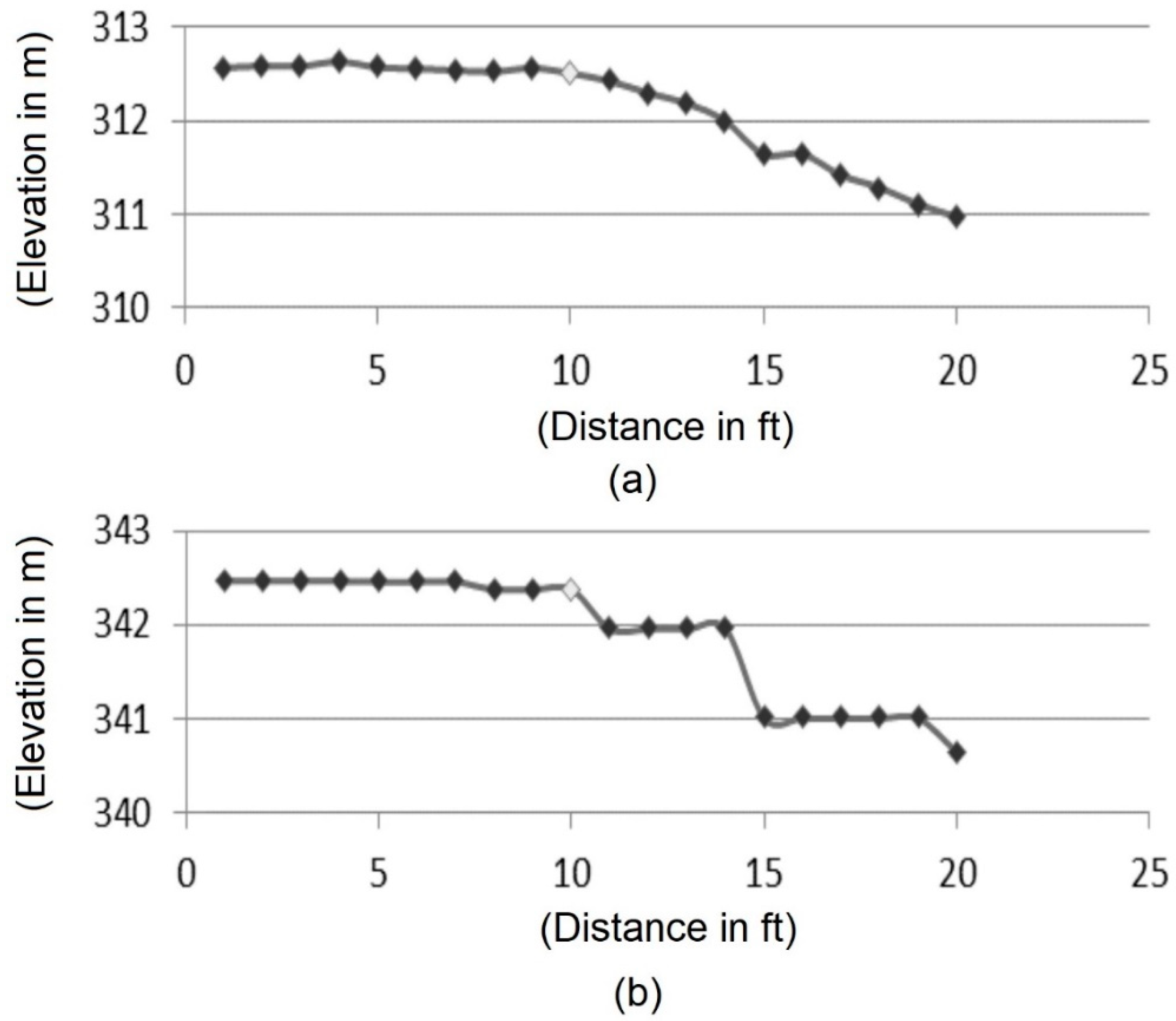
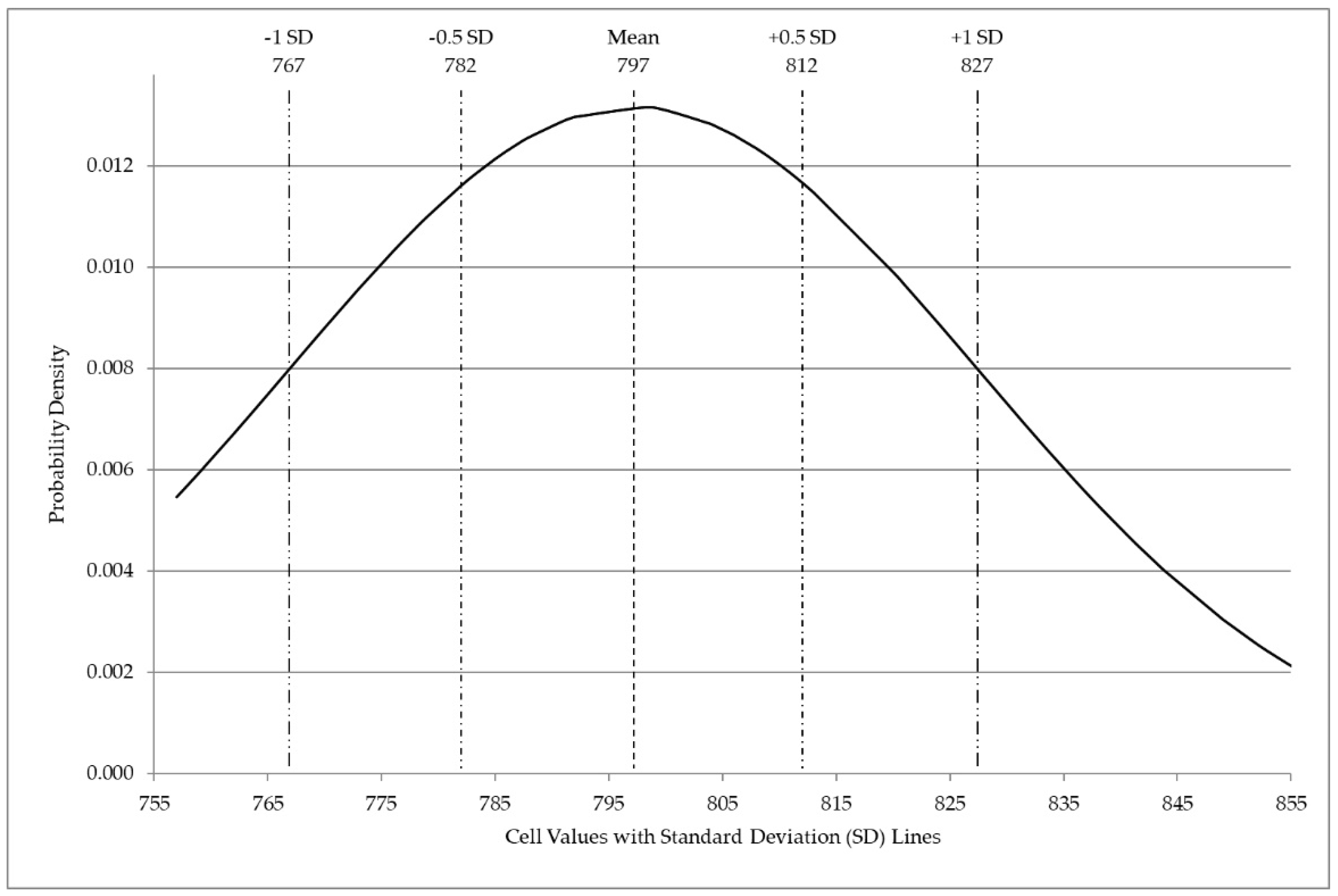
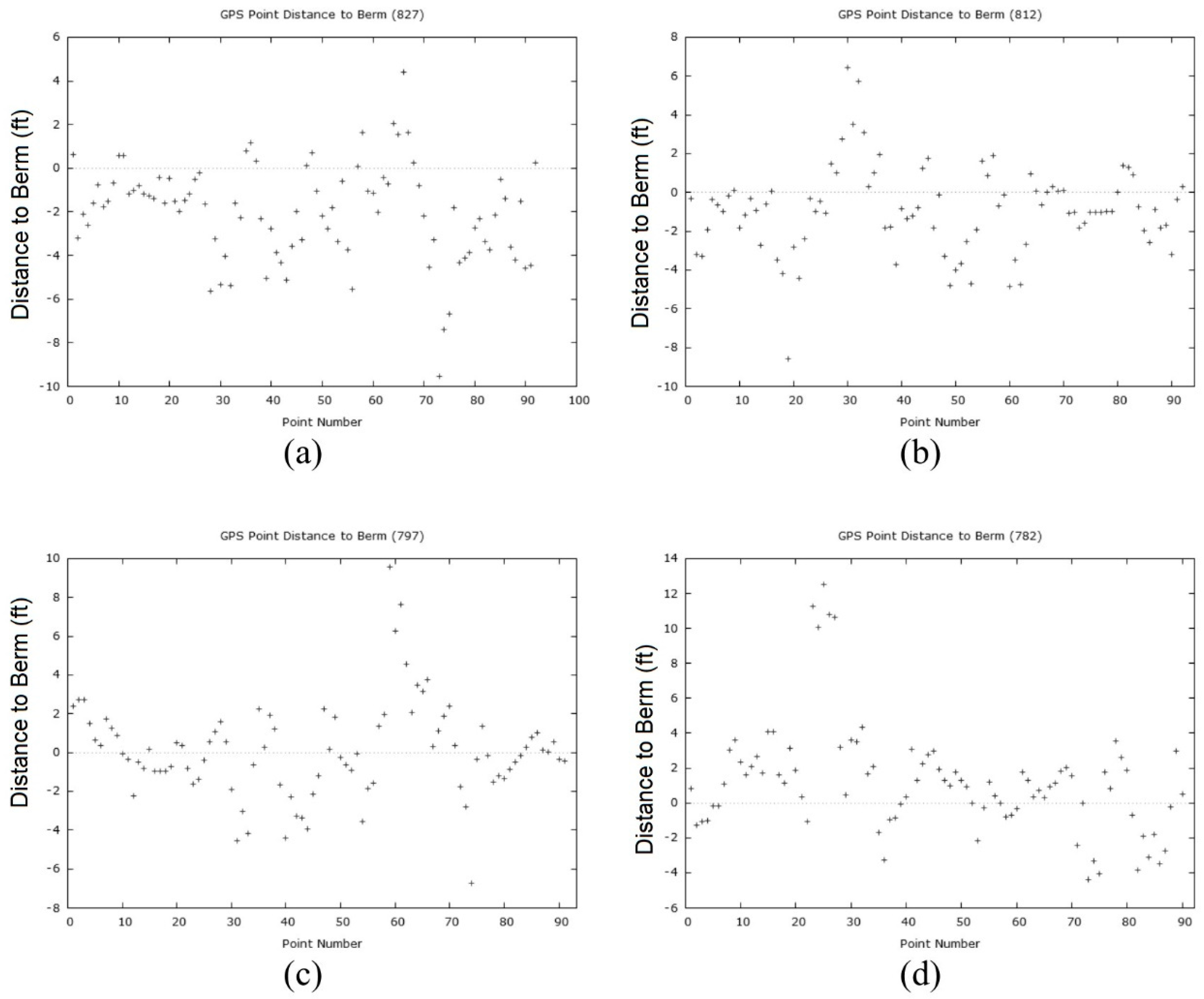
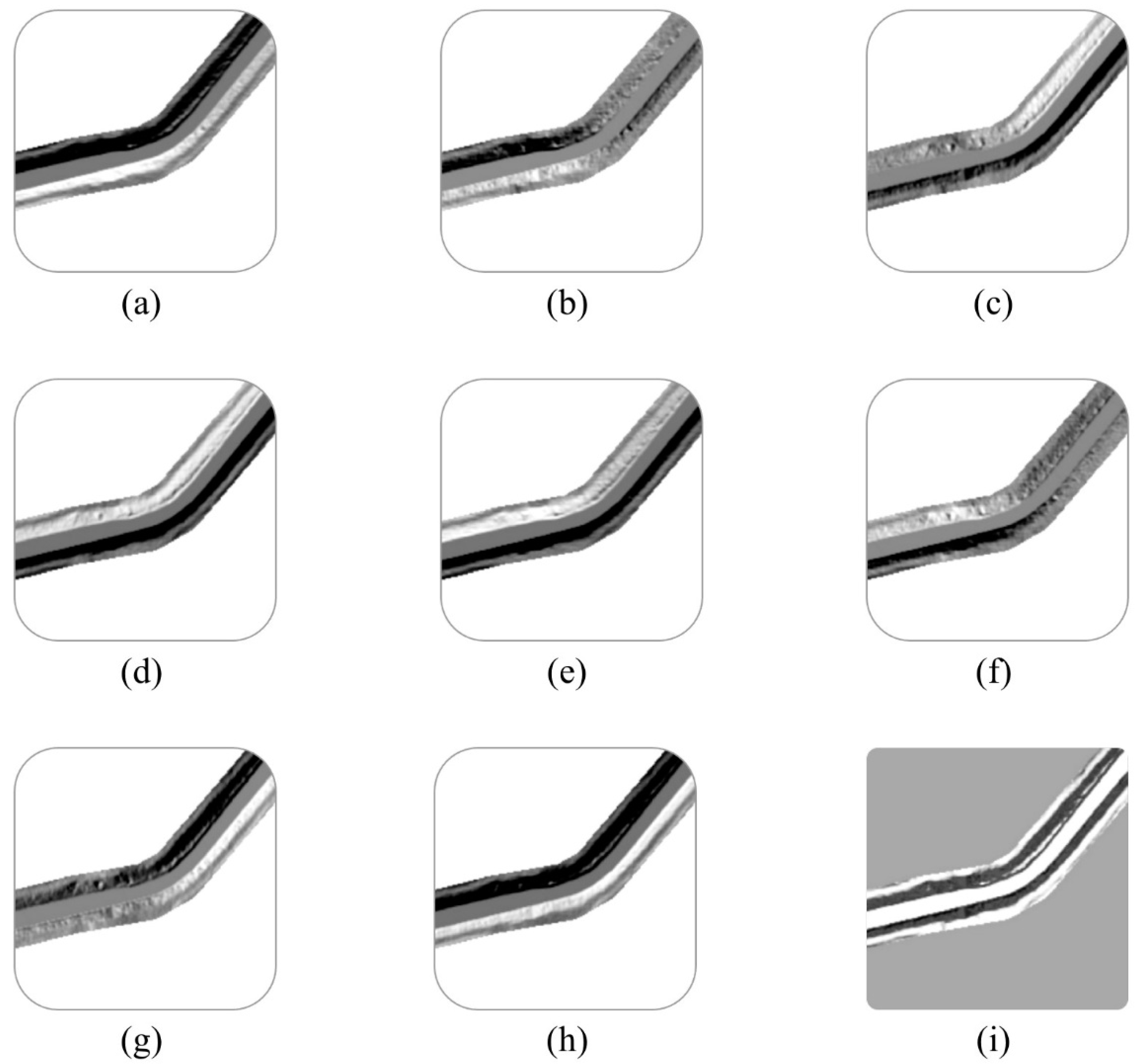

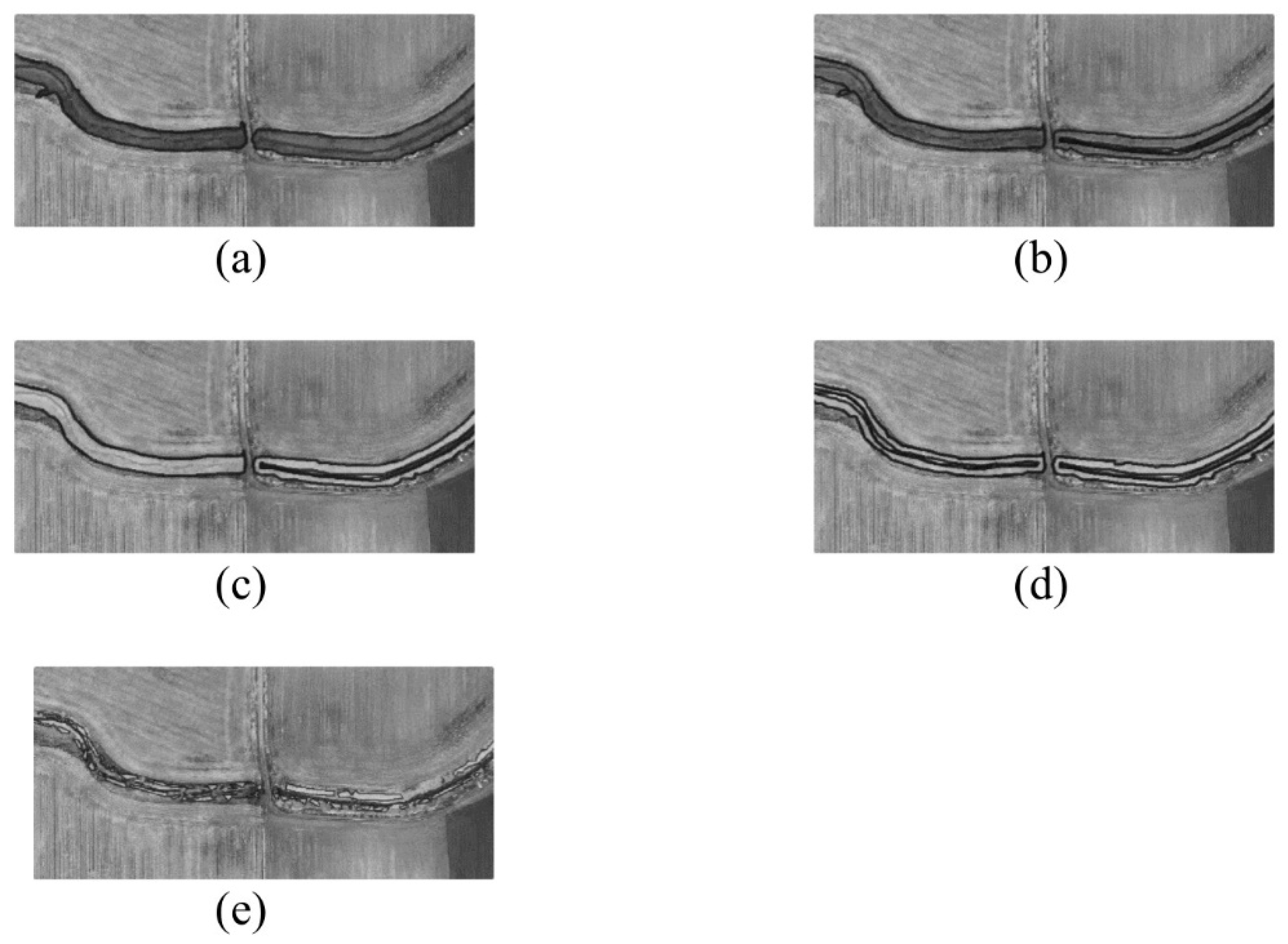
| STDEV | Extracted Cell Value | % of Length of Ditch Berms Completed |
|---|---|---|
| +1 | 827 | 79.80% |
| +0.5 | 812 | 67.30% |
| Mean | 797 | 51.70% |
| −0.5 | 782 | 38.70% |
| −1 | 767 | 3.20% |
| Ditch System | Total Buffer Acres | Building Site | Grasses | Lake or Wetland | Meadow | Right-of-Way | Wood | Tillable | Violation Acres |
|---|---|---|---|---|---|---|---|---|---|
| JC 6 | 23.11 | 1% | 37% | 4% | 0% | 7% | 0% | 51% | 11.90 |
| JD 51 | 25.48 | 2% | 48% | 0% | 0% | 5% | 0% | 46% | 11.68 |
| CD 8A | 39.87 | 0% | 25% | 0% | 45% | 3% | 0% | 26% | 10.33 |
| CD 38 | 17.62 | 2% | 22% | 2% | 20% | 3% | 0% | 51% | 9.07 |
| CD 1 | 21.84 | 1% | 60% | 0% | 5% | 5% | 1% | 28% | 6.04 |
| CD 35 | 7.00 | 3% | 22% | 0% | 0% | 2% | 0% | 72% | 5.03 |
| JD 5 | 22.08 | 0% | 67% | 2% | 8% | 1% | 1% | 21% | 4.66 |
| JD 10 | 15.61 | 0% | 47% | 0% | 23% | 1% | 0% | 28% | 4.38 |
| CD 48 | 9.78 | 0% | 53% | 0% | 0% | 3% | 0% | 43% | 4.23 |
| CD 47 | 5.33 | 0% | 13% | 0% | 6% | 4% | 0% | 76% | 4.07 |
| CD 3 | 32.55 | 0% | 30% | 56% | 2% | 1% | 1% | 10% | 3.28 |
| CD 45 | 15.30 | 0% | 65% | 1% | 5% | 6% | 0% | 21% | 3.25 |
| CD 36 | 9.73 | 1% | 59% | 14% | 0% | 1% | 0% | 25% | 2.47 |
| CD 30 | 15.41 | 0% | 60% | 11% | 6% | 1% | 5% | 16% | 2.44 |
| CD 50 | 4.12 | 1% | 45% | 0% | 0% | 1% | 0% | 53% | 2.19 |
| CD 27 | 5.97 | 2% | 37% | 0% | 0% | 15% | 11% | 34% | 2.01 |
| CD 31 | 11.36 | 0% | 42% | 31% | 4% | 6% | 0% | 18% | 2.01 |
| JD 11 | 28.01 | 0% | 84% | 1% | 3% | 4% | 0% | 7% | 1.95 |
| CD 29 | 14.86 | 0% | 50% | 24% | 6% | 7% | 0% | 12% | 1.80 |
| CD 40 | 8.80 | 0% | 0% | 0% | 63% | 22% | 2% | 12% | 1.09 |
| CD 26 | 2.10 | 0% | 43% | 0% | 2% | 2% | 2% | 52% | 1.08 |
| JD 1 | 9.77 | 0% | 94% | 0% | 0% | 0% | 0% | 6% | 0.62 |
| JD 24 | 27.91 | 1% | 82% | 6% | 8% | 1% | 0% | 2% | 0.58 |
| CD 43 | 6.00 | 0% | 50% | 0% | 16% | 6% | 23% | 4% | 0.23 |
| JD 8 | 4.34 | 0% | 95% | 0% | 0% | 2% | 0% | 3% | 0.12 |
| CD 33 | 3.99 | 1% | 81% | 0% | 13% | 2% | 0% | 2% | 0.10 |
| CD 46 | 3.00 | 0% | 96% | 0% | 0% | 1% | 0% | 2% | 0.07 |
| CD 15-2 | 4.42 | 0% | 98% | 0% | 0% | 0% | 0% | 2% | 0.07 |
| CD 34 | 0.35 | 0% | 0% | 0% | 50% | 0% | 47% | 3% | 0.01 |
| CD 28 | 1.10 | 0% | 0% | 52% | 48% | 0% | 0% | 0% | 0.00 |
| CD 44 | 3.96 | 0% | 12% | 85% | 1% | 3% | 0% | 0% | 0.00 |
Publisher’s Note: MDPI stays neutral with regard to jurisdictional claims in published maps and institutional affiliations. |
© 2020 by the authors. Licensee MDPI, Basel, Switzerland. This article is an open access article distributed under the terms and conditions of the Creative Commons Attribution (CC BY) license (http://creativecommons.org/licenses/by/4.0/).
Share and Cite
Graves, J.; Mohapatra, R.; Flatgard, N. Drainage Ditch Berm Delineation Using Lidar Data: A Case Study of Waseca County, Minnesota. Sustainability 2020, 12, 9600. https://doi.org/10.3390/su12229600
Graves J, Mohapatra R, Flatgard N. Drainage Ditch Berm Delineation Using Lidar Data: A Case Study of Waseca County, Minnesota. Sustainability. 2020; 12(22):9600. https://doi.org/10.3390/su12229600
Chicago/Turabian StyleGraves, Jonathan, Rama Mohapatra, and Nicholas Flatgard. 2020. "Drainage Ditch Berm Delineation Using Lidar Data: A Case Study of Waseca County, Minnesota" Sustainability 12, no. 22: 9600. https://doi.org/10.3390/su12229600
APA StyleGraves, J., Mohapatra, R., & Flatgard, N. (2020). Drainage Ditch Berm Delineation Using Lidar Data: A Case Study of Waseca County, Minnesota. Sustainability, 12(22), 9600. https://doi.org/10.3390/su12229600




